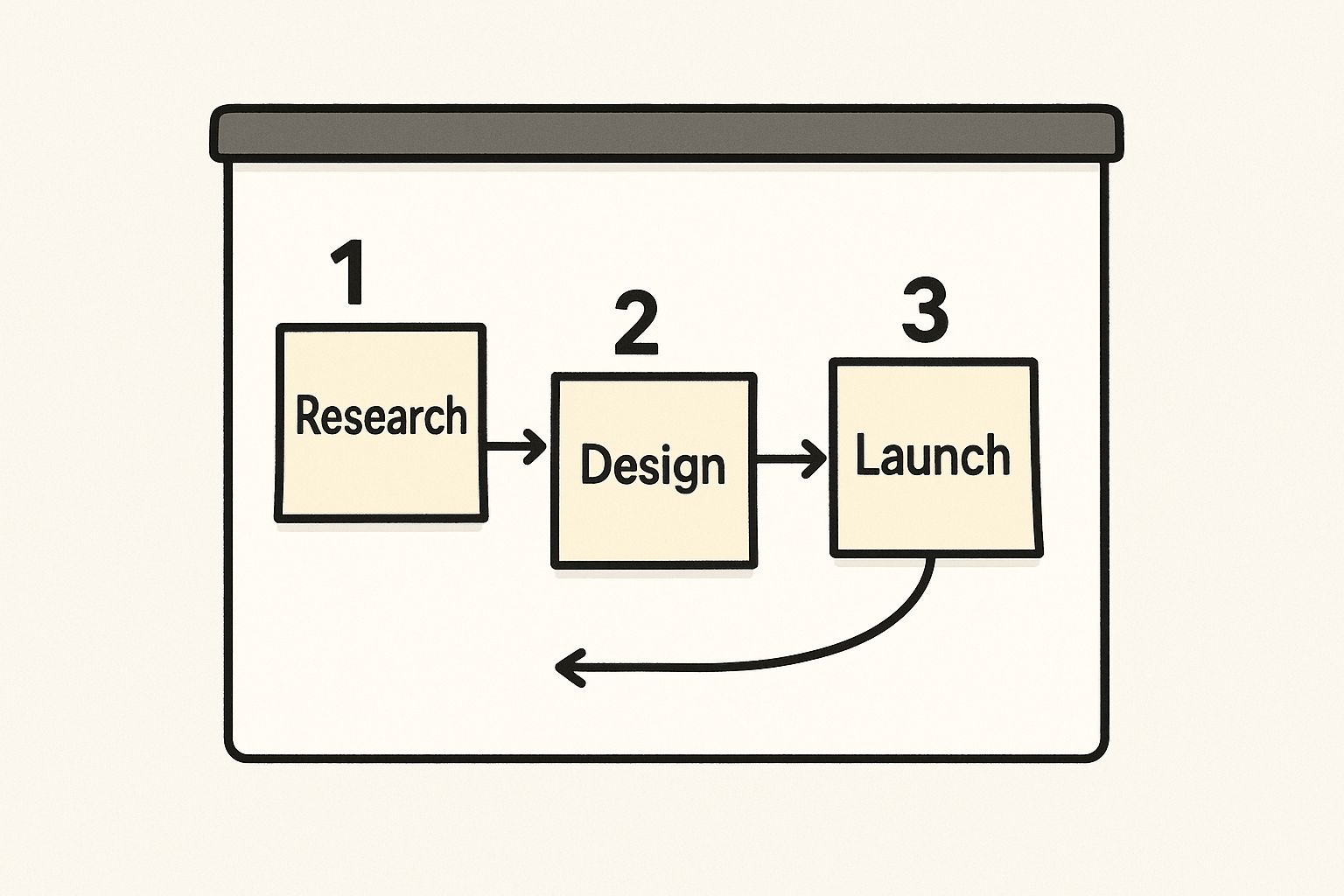Why Re-Launching a Brand Matters Now More Than Ever

In today’s fast-paced market, businesses are constantly facing new challenges. The rapid rise of digital platforms has dramatically changed how customers interact with brands. Shifting customer values require companies to constantly adapt their messaging and what they offer. Increased competition also means brands must innovate to stay ahead of the curve. This has created an environment where re-launching a brand is no longer a choice, but a necessity for survival and growth.
The Urgency of Brand Evolution
The modern business world demands flexibility and the ability to adapt quickly. Brands clinging to old strategies risk being left behind. Remember Blockbuster’s failure to adapt to the changing landscape of the movie rental industry? The arrival of streaming services like Netflix disrupted the market, leaving Blockbuster in the dust. This underscores the vital difference between superficial changes and a true strategic repositioning. A simple logo update isn't enough; a brand needs a strong foundation to build upon.
Customer expectations are also higher than ever. People look for authenticity, transparency, and personalized interactions with brands. This means businesses must constantly evolve to meet these changing expectations. A logo refresh is a surface-level change. A true brand relaunch requires a deep dive into the brand’s purpose, values, and the people it serves.
The Rise of Rebranding
The shift towards brand transformation is clear in recent data. Since 2020, an impressive 75% of companies have rebranded in some way, with 51% directly responding to the COVID-19 pandemic. These changes are driven by shifting customer needs and a fluctuating economic landscape. Rebranding empowers companies to maintain relevance and competitive edge by revitalizing their image and aligning strategies with current market trends. Find more detailed statistics here
Beyond Cosmetics: Strategic Repositioning
A successful relaunch is more than just a superficial makeover; it's a strategic repositioning of your brand in the market. This requires a deep understanding of your competition and the ever-evolving needs of your target audience. It involves revisiting the heart of your brand – its core values – and making sure they resonate with today’s customers.
Recognizing the Warning Signs
Several key indicators signal it might be time for a brand refresh. Dropping sales, slow growth, and negative customer feedback are all obvious warning signs. But there are more subtle indicators too, such as a misalignment between your internal company culture and the message you project externally. Identifying these warning signs early is critical for a successful relaunch. Being proactive allows for thorough planning and strategic execution, maximizing the impact of the changes.
To illustrate this point, consider the following table:
Key Drivers of Brand Relaunch Decisions
| Motivation Factor | Percentage of Companies | Typical Timeline to Action |
|---|---|---|
| Declining Sales | 35% | 6-12 Months |
| Stagnant Growth | 25% | 12-18 Months |
| Negative Customer Feedback | 20% | 3-6 Months |
| Internal/External Misalignment | 15% | 18-24 Months |
| Competitive Disruption | 5% | Immediate – 6 Months |
This table highlights the various factors that influence a company's decision to relaunch, along with the usual time it takes to implement such a change. Notice how negative customer feedback often leads to quicker action compared to internal cultural mismatches. This emphasizes the importance of staying attuned to customer perception and adapting swiftly to address concerns.
Just as a ship needs to correct its course in changing waters, a brand must adapt to thrive in today’s dynamic market. A well-executed relaunch can breathe new life into your brand and propel it toward long-term success.
The 7-Step Framework for Re-launching a Brand That Works

Re-launching a brand is more than just a cosmetic makeover; it's a strategic undertaking. It demands a deep dive into your brand's essence, recognizing its strengths, acknowledging its weaknesses, and uncovering opportunities for growth. This holistic approach helps avoid costly mistakes and ensures your revitalized brand connects with your target audience. This process flow infographic visually outlines the 7-step framework we’ve developed to guide you. The infographic illustrates each phase of the re-launching journey, creating a clear path to success.
This infographic details the 7 key phases of a brand relaunch:
- Market Research & Analysis: Understanding the competitive landscape and your target audience.
- Brand Audit & Assessment: Honestly evaluating your current brand’s strengths and weaknesses.
- Define Brand Purpose & Values: Articulating your brand's core mission and beliefs.
- Develop Visual Identity & Messaging: Creating a cohesive look and feel, inside and out.
- Internal Alignment & Training: Equipping your team to live and breathe the new brand.
- Strategic Rollout & Launch: Executing a well-planned launch across all touchpoints.
- Performance Measurement & Optimization: Tracking results and making data-driven improvements.
The sequential nature of this framework is paramount. Each step builds upon the previous one, forming a solid foundation for lasting success. The visual clarifies this essential flow.
Understanding the Re-launching Process
This 7-step framework is your blueprint for a successful brand re-launch. Within each step lie specific tasks and considerations that shape the overall outcome. For example, the market research phase involves analyzing customer behavior, recognizing emerging trends, and learning from your competition.
This knowledge informs the subsequent brand audit, pinpointing areas for improvement. A well-executed internal alignment program ensures that your team understands and embraces the new brand, delivering a consistent message.
When evaluating the complexities of a rebrand, understanding the scope is critical. A 2023 Bynder survey revealed that the average rebranding process takes approximately seven months. This timeframe can fluctuate based on company size and the number of assets requiring updates. Often, this number exceeds 200 assets, encompassing logos, packaging, and digital materials. Updating marketing assets, especially online content, presents a common challenge. Find more detailed statistics here.
Building a Cohesive Brand Identity
A cohesive brand identity is your connection point with your audience. This means ensuring your visual elements, such as your logo and color palette, align perfectly with your messaging. This harmony fosters brand recognition and trust, solidifying your brand's market presence.
Ensuring Internal Alignment
Internal alignment is often underestimated but absolutely essential. When your team embodies the re-launched brand, they become its most powerful advocates. This guarantees that every customer interaction, both online and offline, reinforces the brand's revitalized image.
Measuring Your Results
Measuring your re-launch's impact is vital. Setting clear Key Performance Indicators (KPIs) and consistently tracking them provides the insights you need. These KPIs might include website traffic, sales figures, social media engagement, and customer feedback. Analyzing this data allows you to identify what’s working and where adjustments are needed, maximizing your return on investment.
Before we continue, let's take a look at a helpful resource. The following table offers a comprehensive checklist of brand assets that typically require updating during a rebranding process.
A detailed breakdown of all brand assets requiring updates during a rebranding process, categorized by priority and complexity, is presented in the table below.
| Asset Category | Examples | Update Priority | Typical Completion Time |
|---|---|---|---|
| Core Visual Identity | Logo, color palette, typography | High | 4-6 weeks |
| Marketing Materials | Website, brochures, presentations | High | 6-8 weeks |
| Digital Assets | Social media profiles, email templates | Medium | 3-4 weeks |
| Internal Documents | Letterhead, business cards | Medium | 2-3 weeks |
| Physical Signage | Office signage, retail displays | Low | 1-2 weeks |
This table highlights the varying levels of priority and estimated completion times for different asset categories, aiding in efficient project management. Focusing on high-priority items like core visual identity and marketing materials first ensures a strong foundation for the rebrand.
This structured approach to asset management empowers you to effectively navigate the rebranding process, optimizing both time and resources.
Brand Relaunch Success Stories: Behind the Transformations

Re-launching a brand successfully demands a deep understanding of the market, strategic thinking, and consistent action. It’s more than a cosmetic makeover; it's about transforming how your audience connects with your brand. This section explores inspiring brand transformations, revealing the hurdles, the key decisions, and the remarkable results.
Old Spice: Breathing New Life Into a Classic
By the late 2000s, Old Spice was seen as a relic of the past, clinging to an aging customer base. But in 2010, the brand embarked on a journey of reinvention. A redesigned logo and website honored its heritage while embracing a contemporary aesthetic. Their advertising strategy took a bold turn towards humorous and viral content, effectively capturing a younger audience. The result? A 107% surge in body wash sales, propelling Old Spice to the top of the U.S. men's body wash market. Learn more about Old Spice’s remarkable transformation here. This story demonstrates how a well-executed rebrand can revitalize a company, aligning with evolving consumer preferences and harnessing the power of social media.
Apple: A Return to Simplicity
Facing near bankruptcy in the late 1990s, Apple's resurgence is a testament to the power of focus. They re-launched their brand with a commitment to simplicity and innovation. The launch of the iMac, with its vibrant colors and user-friendly design, marked a turning point. This daring move, coupled with a streamlined product line and targeted marketing, revived the company and secured its place as a tech industry leader.
Lego: The Power of the Brick
Lego's journey highlights the importance of staying true to your core. After a period of diversification that diluted its brand identity, Lego returned to its roots: the iconic brick. They simplified product lines, invested in captivating content, and nurtured a vibrant community. This revitalization strategy led to a dramatic turnaround, solidifying Lego’s position as a beloved and successful toy brand.
Burberry: From Classic to Cutting-Edge
Burberry, a venerable British brand, faced dwindling relevance in the early 2000s. Their re-launch positioned them as a modern luxury fashion house, attracting a younger, more fashion-forward audience. Modernized product lines, an updated visual identity, and strategic use of digital platforms expanded their reach. This shift successfully established Burberry as a trendy and desirable brand, sparking significant growth.
Airbnb: Redefining the Travel Experience
Airbnb's transformation from a simple air mattress rental service to a global hospitality platform is a story of expansion and evolution. By broadening its offerings to include experiences and local tours, Airbnb became more than just a place to stay; it became a gateway to unique travel adventures. This strategic shift expanded its appeal and established Airbnb as a major force in the travel industry.
Key Takeaways From These Transformations
These stories share common threads that contribute to successful brand relaunches:
-
Understanding Your Audience: Deep market research is essential. Knowing your target audience’s needs and preferences is fundamental to creating a brand that resonates.
-
Clarity of Purpose and Values: Defining a clear brand purpose and a strong set of values guides every aspect of the relaunch.
-
Cohesive Positioning and Execution: A consistent brand experience across all platforms reinforces the re-launched brand message.
-
Adaptability and Innovation: Embracing change and fostering innovation are vital for long-term success.
-
Authenticity and Connection: Building genuine connections with your audience through authentic storytelling is key.
These brand transformations demonstrate the power of strategic re-launching. By learning from these successes, you can gain valuable insights for your own brand’s evolution.
Avoiding the Brand Relaunch Pitfalls That Sink Companies
Re-launching a brand can breathe new life into a company. However, it's a complex undertaking, filled with potential hazards. This section explores common pitfalls that can derail even the most well-planned rebrands, offering insights from seasoned executives and brand consultants. Understanding these risks is the first step toward minimizing them and ensuring a successful relaunch.
The Perils of Insufficient Research
One of the most frequent mistakes is inadequate stakeholder research. This can lead to tone-deaf positioning, where the rebranded image misses the mark with the target audience. For example, a brand trying to connect with a younger demographic might use trendy slang in its messaging, only to alienate its core customer base. Thorough research, including surveys, focus groups, and competitor analysis, is essential for understanding your audience and their needs.
Abandoning Core Brand Values
Another pitfall is abandoning the core values that first drew customers in. While evolving is essential, a complete overhaul can alienate loyal customers who resonate with the brand's existing identity. Imagine a trusted, family-friendly brand suddenly adopting a provocative, edgy persona. This dramatic shift can confuse and alienate its established base. Maintaining a balance between innovation and heritage is critical for a successful re-launch.
Inconsistent Implementation Across Touchpoints
Inconsistency in implementing the rebrand across various touchpoints creates brand confusion. If the website, social media profiles, and physical stores project different brand messages, customers will be left disoriented and unsure of what the brand represents. This lack of cohesion can erode trust and damage the brand's credibility. Picture a company with a sleek, modern website, but outdated, cluttered packaging. This disconnect undermines the intended message. A unified brand experience across all platforms is paramount.
Internal Resistance: A Silent Saboteur
Internal resistance within the company can sabotage a relaunch before it even gains momentum. If employees don't understand or support the rebranding efforts, they won't effectively communicate the new brand message to customers. This lack of internal alignment can appear in various ways, from unenthusiastic customer service to inconsistent marketing materials. For instance, imagine sales representatives continuing to use outdated sales pitches that clash with the rebranded messaging. This internal disconnect can undermine the entire relaunch.
The Danger of Unrealistic Timelines
Rushed timelines often lead to hasty decisions that companies later regret. Insufficient time for research, design, and implementation can result in a poorly executed rebrand that fails to achieve its objectives. A common scenario is rushing the development of a new visual identity, resulting in a logo or color scheme that doesn't effectively represent the brand. This hurried approach can necessitate costly revisions down the road. Adequate time for each stage of the process is a crucial investment.
Preventing the Pitfalls
Avoiding these pitfalls requires careful planning and execution:
- Invest in thorough stakeholder research: Understanding your audience is fundamental.
- Preserve core brand values: Evolve, but don't lose sight of what makes your brand special.
- Ensure consistent implementation: Cohesion across all touchpoints is essential for brand clarity.
- Foster internal alignment: Empowered employees become brand ambassadors.
- Establish realistic timelines: Avoid rushing; allow sufficient time for each phase.
By acknowledging these potential dangers and implementing preventative measures, businesses can navigate the complexities of re-launching a brand and improve their chances of success. A thoughtful, strategic approach is key to transforming your brand's image and achieving lasting, positive results.
Digital Strategies That Amplify Your Brand Relaunch
Relaunching your brand offers a powerful opportunity to revitalize your connection with your audience in the digital world. It's more than just a cosmetic update; it's a chance to amplify your message and create a lasting impact. This means crafting a comprehensive digital strategy that resonates across every point of contact with your customers.
Transforming Your Website: Beyond Visuals
Your website is the digital heart of your brand, and a simple visual refresh isn’t enough during a relaunch. Consider your website's architecture and content. Do they truly reflect your new brand positioning? Does the navigation guide users effortlessly to essential information? Is your content effectively communicating your updated brand story and the value you offer? Think of your website as your brand's online flagship store. Just as with a physical store redesign, you'd go beyond the window display and rethink the entire customer experience.
-
Content Strategy: Create content that not only informs but captivates. Consider diverse formats like blog posts, videos, interactive tools, or downloadable resources.
-
User Experience (UX): Ensure seamless navigation and a positive experience for every user. This includes mobile optimization and fast loading speeds.
-
Search Engine Optimization (SEO): A relaunch is a prime time to refine your SEO strategy. Implement keywords and optimize technical SEO for maximum visibility. Updating your site architecture can significantly improve crawlability and indexing, ultimately boosting your search rankings.
Social Media: Sparking Conversations, Not Just Announcements
Social media platforms are invaluable tools for engaging your audience during a relaunch. Go beyond simple announcements. Spark genuine conversations. Consider running contests, inviting user-generated content, or hosting live Q&A sessions. Generate excitement and invite your customers to be a part of the journey.
-
Campaign Development: Design engaging social media campaigns that showcase your revitalized brand. Use visuals, videos, and interactive content to capture attention and spark discussions.
-
Community Engagement: Actively connect with your followers. Respond to comments and messages. Foster a strong sense of community. This is a chance to build genuine relationships.
-
Influencer Marketing: Partner with influencers who align with your brand values and can authentically share your story. This can expand your reach and build credibility.
Email Marketing: Reconnecting With Your Audience
Email marketing is a direct line to your existing customers, offering a personal way to reintroduce your brand. Focus on sharing your updated brand story and highlighting the value you provide. Think of it as reconnecting with old friends, sharing what's new and exciting.
-
Personalized Messaging: Segment your email list and customize your messages to resonate with specific customer groups. Personalization demonstrates that you value each individual.
-
Value-Driven Content: Deliver content that educates and empowers your audience. This strengthens your relationship and positions you as a trusted resource.
-
Relaunch Announcement: Craft a dedicated email campaign to announce your relaunch, emphasizing the key changes and the benefits for your customers.
By strategically integrating website updates, social media campaigns, and email marketing, you can create a cohesive digital experience that magnifies your brand relaunch's impact. This multifaceted approach ensures that your rebrand resonates with your target audience, driving genuine engagement and setting the stage for lasting success. A well-crafted digital strategy harmonizes different channels to create a powerful and memorable brand experience, setting a successful relaunch apart from a simple update.
Measuring What Actually Matters in Your Brand Relaunch
Re-launching a brand represents a significant investment. Just like any investment, you need to track its performance. This means going beyond superficial vanity metrics like the number of social media followers. Instead, concentrate on data that genuinely reflects the success of your relaunch. Think of it like renovating a house. You wouldn't measure success solely on the shine of new doorknobs. You'd assess the overall increase in property value. This section offers a framework for measuring what truly counts, guaranteeing your brand transformation delivers substantial results.
Establishing Clear KPIs Before Launch
Before you even start the relaunch, defining clear Key Performance Indicators (KPIs) is essential. These KPIs should align perfectly with your business goals, providing a roadmap to track progress and measure the effectiveness of your work. They must be specific, measurable, achievable, relevant, and time-bound (SMART).
-
Awareness Indicators: If your objective is heightened brand awareness, track metrics like website traffic, social media mentions, and media coverage.
-
Engagement Signals: For enhanced customer engagement, measure social media interactions, email open rates, and time spent on your website.
-
Conversion Data: Aiming for higher conversions? Focus on key metrics like sales figures, lead generation, and customer acquisition cost.
Selecting the right KPIs empowers you to focus your resources strategically and make data-driven decisions throughout the relaunch. If your main aim is increased sales, tracking website traffic alone won't suffice. You need a more complete view.
Quantitative vs. Qualitative Assessments
Measuring your brand relaunch requires both quantitative data and qualitative assessments. Quantitative data provides the hard numbers, while qualitative assessments offer deeper insights into customer perception and brand sentiment.
-
Quantitative Measures: Monitor metrics like the increase in sales, changes in market share, growth in website traffic, and conversion rates. These numbers offer tangible proof of your relaunch's impact.
-
Qualitative Assessments: Conduct customer surveys and use tools like social listening and sentiment analysis to understand how your audience perceives your re-launched brand. This reveals valuable insights into customer opinions, adding context to the quantitative data.
Imagine your website traffic increases after the relaunch, but sales remain flat. Qualitative data, such as customer feedback, might reveal that the new website design is confusing, or the product information is unclear. Combining both types of data paints a more complete picture.
Realistic Measurement Timelines
Setting realistic timelines for measuring your relaunch's impact is paramount. Some metrics, like website traffic, may show immediate changes. Others, like shifts in brand perception, require more time. A revamped website might attract more visitors within days. But building trust and altering customer opinions takes months, much like nurturing a garden. You wouldn't anticipate a harvest the day after planting seeds.
Understanding these varying timelines prevents premature conclusions and allows for continual adjustments.
Interpreting Results and Ongoing Refinements
Honestly evaluating your results, both positive and negative, is vital. Acknowledge areas of success and identify areas for improvement. This honest assessment allows for data-driven adjustments, maximizing your return on investment. It creates a feedback loop of analyzing, adjusting, and improving.
For instance, if social media engagement is lower than anticipated, revisit your social media strategy and try different content formats. This iterative approach ensures continuous improvement and maximizes the long-term success of your relaunch. Using data to guide your decisions transforms your relaunch from a single event into an ongoing journey of growth and optimization.
Need help crafting a brand relaunch that truly resonates? Henri Den provides expert guidance to solopreneurs, creators, and career shifters seeking to build meaningful personal brands. Discover how clarity, storytelling, and AI can transform your brand's journey. Visit Henri Den today.






